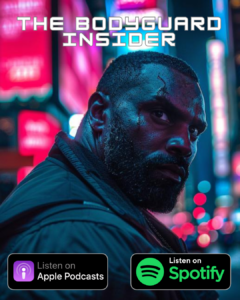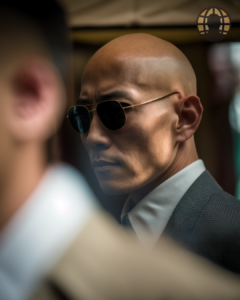
Bodyguard Formations
While on assignments, you will employ four basic bodyguard formations to protect your client depending on the environment, threat level, circumstances, and the number of bodyguards available.
The four basic formations are the wedge, box, diamond, and one-on-one formations, which are structured perimeter defenses formed around the client. These formations remain in close proximity to the client, are highly mobile, and move with the client at all times, shielding the client from encountering any altercations.
While conducting these protective formations as a team bodyguard or on a one-on-one effort, always be alert and position yourself between clients to shield against possible threats. Fully scan the room your client is in. If you sense danger, take action and immediately move the client to safety.
Each formation should be utilized to suit the individual needs of a situation and include the protection of your client while in different functions such as public halls, open space meetings, boardrooms, crowded auditoriums or streets, etc. The shape of the formation never stays perfectly aligned with the geometric configurations described. Still, the most important consideration is maintaining the integrity of protection provided for the client at all times by mitigating potential threats.
Three-Man Wedge Formation

As the name suggests, the wedge formation is a geometric configuration of a wedge. The rule in the wedge formation is to provide the client with 360 degrees of protection. The wedge is the most difficult formation for maintaining perimeter integrity around the client and is mostly utilized in moving the client through heavy, low-risk crowds. The wedge should only be used in a tight protective formation and is normally conducted in an overt movement.
VIP Box Formation
The box formation, as the name suggests, is a geometric configuration of a box. The rule in the box formation is to provide the client with 360 degrees of protection at all times. The box is to be utilized in moderate to high-risk crowds and is a fairly easy formation for maintaining perimeter integrity around the client. The box can be used in loose and tight protective formations and conducted in a covert or overt movement.
Diamond Formation VIP Protection
As the name suggests, a diamond formation is the geometric configuration of a diamond. The rule in the diamond formation is always to provide the client with 360 degrees of protection. The diamond can be used in loose and tight protective formations and conducted in a covert or overt movement.

One-On-One Bodyguard Formations
The one-on-one formation is normally utilized within a low-threat area on a low-threat client. The rule in the one-on-one formation is to provide the client 360 degrees of protection while utilizing low public profile techniques. The lone bodyguard is responsible for the client’s flank, point, tail, and close-in protection. The one-on-one can be used in a loose, tight protective formation and should be conducted covertly.
Responsibilities & Position Categories
Walking formations are set up around the client to ensure a threat can not breach security and get close to the principal while he or she is on foot.
Protective agents should maintain 360-degree security coverage around the principal, looking for potential threats. In the event of an attack on the principal, the agents should surround, shield, and evacuate him or her instantly.
The Point Bodyguard
The point bodyguard guides the protective team and blocks and heads off potential threats from the front of the protective formation.
The Flank Bodyguard
The flank bodyguard blocks and heads off potential threats from the sides of the protective formation.
The Rear Bodyguard
The rear bodyguard blocks and heads off potential threats from the back of the protective formation.
The Detail Leader
The Detail Leader walks immediately to the right of the principal and should be at least an arm’s length away from him or her. He or she is responsible for immediately shielding and removing the principal in the event of an attack.
Whatever formation you employ (wedge, box, diamond, or one-on-one), if you see signs of impending assault or aggression against your client, such as the appearance of a weapon, you must communicate this threat to the other bodyguards on your team.
Shout the word “gun right” or “gun left” while concurrently nullifying the assault. Upon hearing this communication, the other bodyguards will simultaneously encircle and shield the client with their bodies, withdrawing the client from the area to a vehicle, a safe haven, or any other location where injury can be avoided. High-level proficiencies are required.
React proactively if any threatening behavior has been detected. Upon threatening actions (physical assault, shots fired, a handgun or knife assault) shield the client from attack. This means placing your body between the client’s body; protecting him or her from harm.
Quick response time is essential to the safety of the client. Remove the client from the area and evacuate the client to safety. The bodyguard closest to the threat may delay the attacker while the other bodyguards surround and shield the client with their bodies, with the team leader guiding the client to safety. Continually practice your bodyguard formation drills and attack on principal (AOP) drills over and over until they become instinctive. Always be safe, and Godspeed.
Doc Rogers is the author of Corporate Executive Protection—A Manual for Inspiring Corporate Bodyguards and the president and CEO of International Corporate Executive Protection Ltd. Doc has earned a Ph.D. in Security Administration from Southwest University and is SE Asia’s leading expert on executive protection and corporate security. To learn how to make a full-time living as a corporate bodyguard, visit the websites below for more information.

http://www.trafford.com/Bookstore/BookDetail.aspx?Book=182707
http://www.amazon.com/Corporate-Executive-Protection-Inspiring-Bodyguards/dp/1425135927
http://international-corporate-executive-protection.com/order.asp

hi guys
Mr Doc rogers thanks for the great information on the bg formations. i always wanted to know what kinda Bg formation does a president or prime minister uses. Do you have any information on that.
again thank you and appreciated.
regards
jan
Rey, Jerry, Frank, James, Rick, and Six: Thanks so much for the kind comments. You are all true professionals in the industry and I am happy to be associated with you through bodyguardcareers and Hucky Austin! Keep safe and God speed.
Doc,
As always thanks for your contributions. When a threat is recognized I am a fan of identifying the threat by positions on the clock as it allows the team to zone in on the threat easier. Gun 2 o’clock red automobile or Gun 10 o’clock second floor window, provides enhanced focus. It also keeps the team from accidentally moving into the threat.
Doc–
Great article and as Jerry already noted, the key to any type of movement is 360 degrees of coverage; not only around us, but spherically above and below as well. We have to know what’s below the surface we’re walking/driving on (ie below stages, bridges etc), and we always have to remind ourselves to look up as we enter/exit buildings. Another point I’d make is that we teach that the DL is sometimes located slightly to the right/rear, rather than immediately to the right (for a right-handed DL). His/her position would be reversed for a left handed DL. We’ve found this affords better visual coverage with less head/eye movement. It also gets you used to working when the Protectee has a guest immediately on his/her left or right.
Great article Doc!
Nice job about not only the various formations, but also the duties and responsibilities each EP agent has assigned specifically to him or her.
Your article brought back memories of practicing formations for hours in the 110 degree sun in Maryland many years ago. lol
Well written. The key is to train. If you can’t do it correctly in practice, you won’t do it correctly on game day.
Good article Doc. I’ve seen many teams try to choreograph these complicated formations and look silly in the process. You explain the main objective of each in the simple terms they require. 360 degree coverage regardless of the wedge, box, diamond or thrown together on the spot
and dont forget one of the most important things that clients fail to remember THE BUDGET!!!